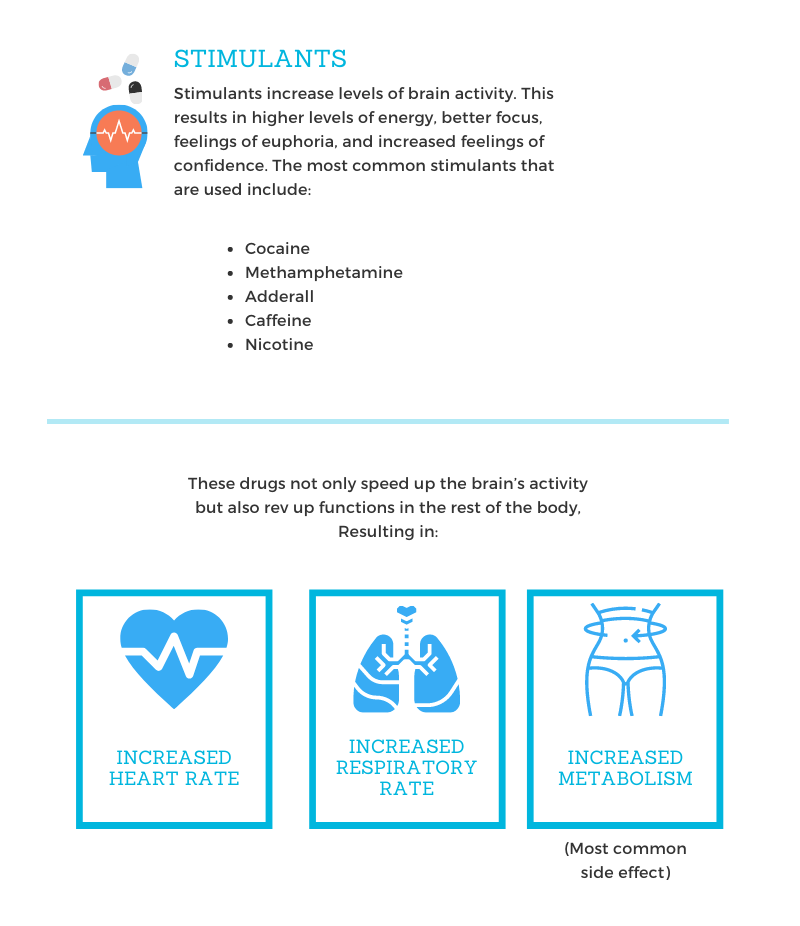If you or a loved one have ever used stimulants recreationally, you know how powerful these drugs are. Stimulants are a class of drugs that increase energy and focus on the user. They are highly addictive, making recreational users and people who are prescribed them at risk of inadvertently developing stimulant addiction. It’s important to be aware of what the signs of stimulant addiction are in order to identify it and treat it as soon as possible.
Whether a person abuses crystal meth or Adderall, abusing these types of drugs is dangerous. Stimulant abuse not only leads to a drug problem, but it poses serious mental and physical health risks to the user. As with any condition, the earlier you identify and treat drug addiction, the better.
What is a Stimulant?
Stimulants increase levels of brain activity. This results in higher levels of energy, better focus, feelings of euphoria, and increased feelings of confidence. The most common stimulants that are used include:
- Cocaine
- Methamphetamine
- Adderall
- Caffeine
- Nicotine
These drugs not only speed up the brain’s activity but also rev up functions in the rest of the body. This results in an increased heart rate, respiratory rate, and metabolism.[1] The increased metabolism and energy produced by stimulant use make weight loss one of the most common side effects. In addition to weight loss, stimulants are very popular among students who use them as a study aid. These desirable side effects, along with the feelings of euphoria that stimulants produce, are the reasons why these drugs are so highly addictive. If you notice that someone is using stimulants for any of these reasons, it’s a sign that they are suffering from addiction.

Short Term Side Effects of Stimulant Abuse
Short term side effects of stimulant abuse can lead to some pleasant side effects such as euphoria but also some very unpleasant side effects. The most common ones are:
- Rapid heart rate or palpitations
- Increased breathing rate
- Anxiety and panic attacks
- Nausea
- Tremors
- Muscle spasms
- Loss of appetite
- Dilated pupils
Stimulants prompt the brain to release high levels of a neurotransmitter called dopamine. [2] Dopamine is one of the “feel-good” hormones in the brain that produces the pleasurable effects people experience when they take stimulants. This release of dopamine stimulants the brain’s reward center, leading to a higher risk of addiction.
Long Term Side Effects of Stimulant Abuse
As someone continues to abuse stimulants, they eventually develop a tolerance to the drug – another sign of a developing stimulant addiction. This means that person needs to take higher doses of stimulants to obtain the same results. Chronic, long-term stimulant abuse leads to more serious side effects than short-term use. Repeatedly stimulating the brain to produce high levels of dopamine alters brain chemistry and makes the body become dependent on stimulants. [3] This leads to other side effects such as:
- Paranoia
- Anxiety
- Depression
- Hallucinations
- Violent outbursts
- Memory loss
- Insomnia
Chronic stimulant use also results in changes in physical appearance. People suffering from stimulant addiction neglect their appearance and nutrition resulting in:
- Severe weight loss
- Tooth decay
- Skin sores
Most of these side effects are reversible after someone stops using stimulants. However, long term stimulant abuse can sometimes result in permanent brain damage. [3]
Signs of Stimulant Addiction
When someone first starts abusing stimulants, it may not immediately be apparent to others that they are struggling with stimulant addiction. As a stimulant addiction progresses, the signs that someone is struggling with addiction become increasingly more noticeable.
Behavioral Changes
People suffering from stimulant addiction show significant changes in behavior. Oftentimes they are withdrawn from friends or family. Sometimes they engage in deceitful or illegal activities such as lying or stealing in order to obtain money to buy more drugs. People abusing stimulants are also more prone to drastic mood swings and emotional outbursts. They typically act erratically and exhibit high energy or manic behaviors such as speaking quickly or fidgeting.
Physical Changes
Other common signs of stimulant addiction are changes in appearance. Stimulant abuse causes people using the drugs to engage in nervous habits such as skin picking and teeth grinding. This leads to open sores on the skin and eventually permanent scarring. It also causes severe dental issues resulting in obvious tooth decay. [3]
Increased Dependency
Over time, people who abuse stimulants will require more and more of the drug to achieve the same results they had when they first started using stimulants. Increasing tolerance and eventually developing a physical and mental dependence on stimulants means that someone has developed an addiction. They need to use higher doses of the drugs and in most cases can never achieve the same initial high.
When someone who is addicted to stimulants stops taking them, they will go into withdrawal. Signs of stimulant withdrawal are:
- Fatigue
- Changes in sleep patterns (sleeping too little or sleeping too much)
- Agitation
- Chills
- Increased appetite
- Cravings for stimulants
Seeking Help for Stimulant Addiction
If you or a loved one is exhibiting signs of stimulant addiction and need drug rehab, it is important to seek help as soon as possible. The most effective treatment for stimulant addiction is residential treatment. At Comprehensive Wellness Centers located in South Florida, we are fully equipped to start you on the road to sobriety.
We are an accredited drug and alcohol treatment center. Our staff is comprised of highly trained addiction therapists that work closely with you to develop a customized treatment plan that fits your individual needs. Contact us today to get started.











